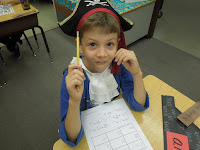Argh! We had such a great "Talk Like a Pirate Day" on Monday. Our whole wing, 1st and 2nd grades, dressed up to celebrate. Click here to learn the history of "Talk Like a Pirate Day." We had fun, pirate-y learning going on all day. The day began by choosing pirate names. They were pretty silly. The students had new names like Big Buckle Charlie and Fearsome Pegleg Patsy. Some students put their pirate name on all their papers! Ha! It sure made correcting papers a little more interesting!
In math, we counted and tallied pirate objects. Then we had to use those numbers to solve addition and subtraction problems. The children worked cooperatively in pairs. They understood how to work as a crew! We also had a crab race relay. The relay had us moving and practicing our math facts. We needed the answers from the math facts to decode a secret pirate message leading to a treasure hunt clue. More on that later in this post. Another pirate-y math activity we did was a cannonball toss. The students tossed a cannon ball (a black balloon filled with rice) back and forth. Each pass they had to say a number in the sequence we were practicing. Some students were practicing counting backwards from 100, some practiced counting by 10's and 5's, some were even skip counting backwards from target numbers given by the captain. Yo, ho, ho!
Later, we folded some pirate hats and learned about the "ar" chunk. We filled our hats with "ar" words and practiced reading and spelling all the words. Then, we tested our ability to read "ar" words with a Q-arrrrr hunt. In the QR hunt, the students scanned QR codes with their ipads. The QR code revealed a word. Students had to read the word and find the picture of the word. When they found the picture, there was another QR code. The students completed the series of clues on the first try! They were an awesome crew!




Toward the end of the day....we found a secret clue! We had to follow a series of different clues to hunt for treasure. The first clue described one of our classroom graphs in the hallway. When we looked behind the graph, we found another clue. Inside the clue back was a series of numbers. We had to have our crab relay races, then the answers to those math problems revealed letters for the message.
The message told us our next clue was outside the counselor's door. There we found another clue that could only be revealed if we painted on it with sea water. That secret message sent us to Mrs. Crum. She had a clue that was a puzzle. The puzzle sent us to the nonfiction section of the library where pirate books could be found.
The students who checked the library found a treasure box! Inside was gold for everyone!! What a grand adventure.
At the end of the day, we had a little more fun with a cannon ball fight. I just adore this crew!



Shiver me timbers! This is a long post and I still wasn't able to include it all! I have even more photos! Our day was filled with learning and fun. We read all sorts of wonderful pirate books, made a pirate graph, played new pirate apps, and all sorts of interesting things. There are two great pirate apps, one for spelling and one for math. Check out Pirates Love to Count and Pirates Love to Read in the App store. Click on the names of the apps to find more information. Yo, ho, ho!










































